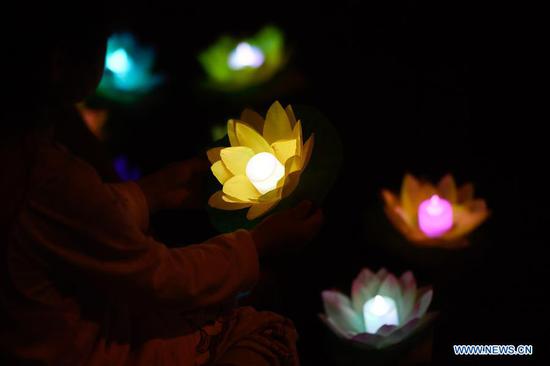A UN report on women published Tuesday shows that no country has achieved gender equality so far and globally there is a long way to go before gender equality is achieved.
Less than 50 percent of working-age women are in the labor market, a figure that has barely changed over the last quarter of a century, according to the World's Women 2020: Trends and Statistics.
Unpaid domestic and care work falls disproportionately on women, restraining their economic potential as the COVID-19 pandemic additionally affects women's jobs and livelihoods, warned the report, which compiles 100 data stories that provide a snapshot of the state of gender equality worldwide.
Presented on an interactive portal, the report analyses gender equality in six critical areas: population and families; health; education; economic empowerment and asset ownership; power and decision-making; and violence against women and the girl child as well as the impact of COVID-19.
"Twenty-five years since the adoption of the Beijing Declaration and Platform for Action, progress towards equal power and equal rights for women remains elusive. No country has achieved gender equality, and the COVID-19 crisis threatens to erode the limited gains that have been made," said UN Secretary-General Antonio Guterres. "The Decade of Action to deliver the Sustainable Development Goals and efforts to recover better from the pandemic offer a chance to transform the lives of women and girls, today and tomorrow."
While unpaid domestic and care work has intensified for both men and women during the COVID-19 pandemic, women continue to do the lion's share. On an average day, women globally spend about three times as many hours on unpaid domestic and care work as men (4.2 hours compared to 1.7). In Northern Africa and Western Asia that gender gap is even higher, with women spending more than seven times as much as men on these activities.
This lopsided distribution of unpaid domestic and care work prevents women from participating in the labor market. In 2020, only 47 percent of women of working age participated in the labor market, compared to 74 percent of men -- a gender gap that has remained relatively constant since 1995. In Southern Asia, Northern Africa and Western Asia, the number is even lower, with less than 30 percent of women participating in the labor market. And the pandemic is expected to exacerbate these gender disparities, as many women work in the subsectors hardest hit by COVID-19 and lockdown measures, including in paid domestic work, accommodation and food services, and the retail trade. Women also make up over 70 percent of workers in the health sector, therefore facing higher infection risks than men in the workplace.
In terms of power and decision-making, women held only 28 percent of managerial positions globally in 2019 -- almost the same proportion as in 1995. And only 18 percent of enterprises surveyed had a female chief executive officer in 2020. Among Fortune 500 corporations only 7.4 percent, or 37 chief executive officers, were women. In political life, while women's representation in parliament has more than doubled globally, it has still not crossed the barrier of 25 percent of parliamentary seats in 2020. Women's representation among cabinet ministers has quadrupled over the last 25 years, yet remains well below parity at 22 percent.
The world has made substantial progress in achieving universal primary education, with girls and boys participating equally in primary education in most regions. While school closures related to COVID-19 are likely to set back progress on access to education, evidence shows that girls, once they have access to schooling, tend to do better than boys in terms of academic achievement. In tertiary education, women outnumber men, and enrolment is increasing faster for women than for men.
However, women continue to be underrepresented in the fields of science, technology, engineering and mathematics, representing only slightly more than 35 percent of the world's STEM (science, technology, engineering and math) graduates. Women are also a minority in scientific research and development, making up less than a third of the world's researchers.
During COVID-19 lockdowns, many women and girls have been isolated in unsafe environments where they are at heightened risk of experiencing intimate partner violence. Around one third of women worldwide have experienced physical and/or sexual violence by an intimate partner; and 18 percent have experienced such violence in the past 12 months. In the most extreme cases, violence against women is lethal: globally, an estimated 137 women are killed by their intimate partner or a family member every day.
While female genital mutilation is becoming less common in some countries, at least 200 million girls and women alive today have been subjected to this specific form of violence across Africa and the Middle East where the practice is most prevalent.
In a sign that attitudes are changing, women's acceptance of being beaten by their partners decreased in almost 75 percent of countries with data over the past seven years. But laws to address domestic violence are not yet universally available, with only 153 countries having such laws. Gaps are largest in Northern Africa, Western Asia and sub-Saharan Africa.
Reliable, timely and disaggregated data are critically needed, particularly now as the international community responds to the COVID-19 pandemic, to effectively measure progress in achieving gender equality. Closing the data and evidence gaps through regular collection and use of gender statistics is crucial.
"I call on all countries to accelerate efforts towards the empowerment of women and girls and towards improving the evidence base to monitor progress: data gaps in the coverage of key gender topics need to be filled," said Liu Zhenmin, UN undersecretary-general for economic and social affairs. "Timeliness and comparability of data over time and across countries need to be improved, and data disaggregation and dissemination by age, sex, location and other key variables need to become a priority in order to fully measure and address intersecting inequalities, respond to crises, and ensure gender equality by 2030."
Produced by the Statistics Division of the United Nations Department of Economic and Social Affairs, the World's Women report has been produced every five years since 1990 and provides the latest data on the state of gender equality worldwide.


















































